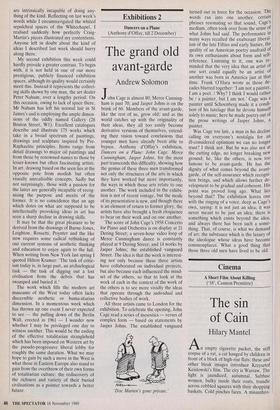Exhibitions 2
Dancers on a Plane (Anthony d'Offay, till 2 December)
The grand old avant-garde
Andrew Solomon
John Cage is almost 80; Merce Cunning- ham is past 70; and Jasper Johns is on the brink of 60. Members of the avant-garde, like the rest of us, grow old; and as the world catches up with the originality of their ideas, they all too easily become derivative versions of themselves, extend- ing their vision toward conclusions that younger men have already been able to bypass. Anthony d'Offay's exhibition, Dancers on a Plane: John Cage, Merce Cunningham, Jasper Johns, for the most part transcends this difficulty, showing how the genius of these three men transformed not only the structures of the arts in which they have worked but more importantly, the ways in which those arts relate to one another. The work included in the exhibi- tion is not of recent vintage, but the mode of its presentation is new, and though there is an element of return to former glory, the artists have also brought a fresh eloquence to bear on their work and on one another.
The score of John Cage's 1958 Concerto for Piano and Orchestra is on display at 21 Dering Street; a seven-hour video loop of Merce Cunningham dance is constantly played at 9 Dering Street; and 14 works by Jasper Johns; the established vanguard Street. The idea is that the work is interest- ing not only because these three artists have collaborated on individual projects, but also because each influenced the mind- set of the others, so that to look at the work of each in the context of the work of the others is to see more vividly the ideas that operate through the individual and collective bodies of work.
All three artists came to London for the exhibition. To celebrate the opening, John Cage read a series of mesostics — verses of complex form — based on statements by Jasper Johns. The established vanguard 'Doc Marten's gone private.' turned out in force for the occasion. The words ran into one another, certain phrases resonating so that sound, Cage's medium, often took over from the sense of what Johns had said. The performance in many ways recalled the exuberant liberal- ism of the late Fifties and early Sixties, the quality of an American poetry unafraid of its own enthusiasms about form and self- reference. Listening to it, one was re- minded that the very idea that an artist of one sort could equally be an artist of another was born in America just at that time. Frank O'Hara wrote as those de- cades blurred together: am not a painter, I am a poet. / Why? I think I would rather be / a painter, but I am not.' Cage was a painter until Schoenberg made it a condi- tion of his tutelage that he devote himself solely to music; here he made poetry out of the prose writings of Jasper Johns, a painter.
Was Cage too late, a man in his decline calling on everyone's nostalgia for an ill-considered optimism we can no longer trust? I think not. But he was also not at the cutting edge, no longer breaking new ground; he, like the others, is now too famous to be avant-garde. He has the dignity of what comes beyond the avant- garde, of the self-assurance which recogni- tion brings, and which allows further de- velopment to be gradual and coherent. His point was proved long ago. What lies beyond that? The exhibition leaves one with the ringing of a voice, deep as Cage's own, saying: it is not just an idea; it was never meant to be just an idea; there is something which exists beyond the idea, and always there has been such a some- thing. That, of course, is what we demand of art: the substance which is the luxury of the ideologue whose ideas have become commonplaces. What a good thing that those three old men have lived to be old.


























































 Previous page
Previous page